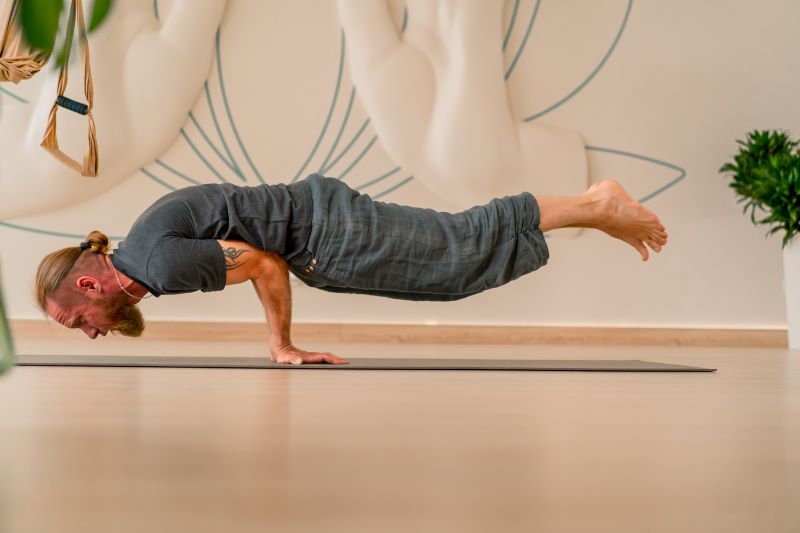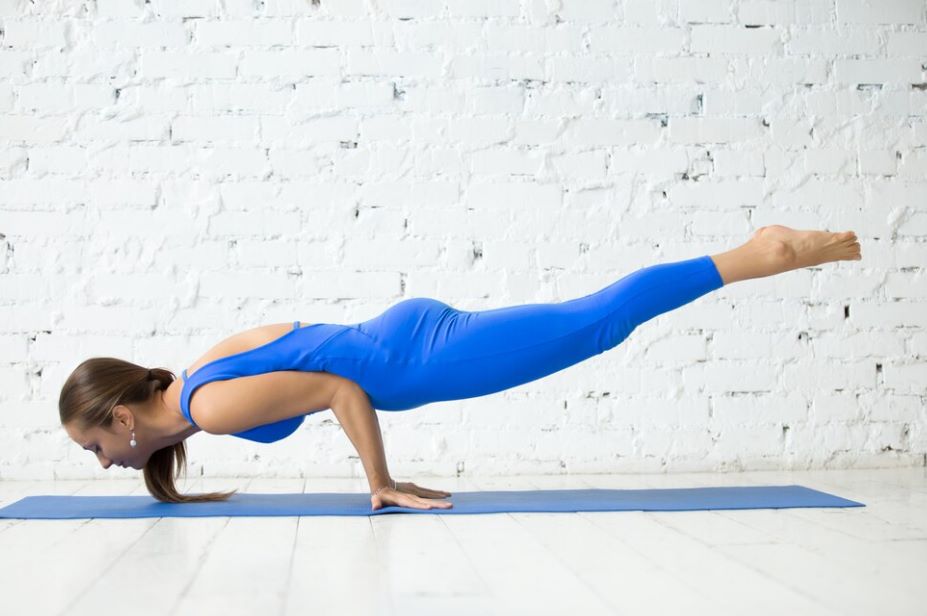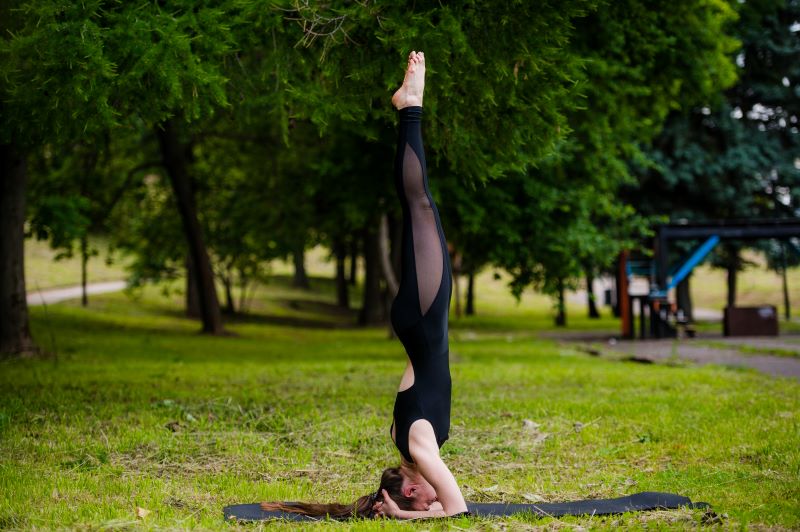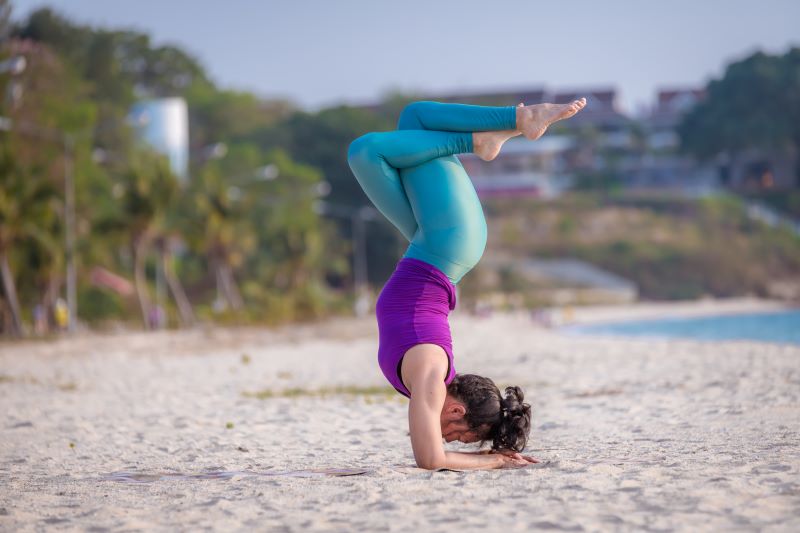15 Health Benefits of Mayurasana & How to Do It?

Mayurasana is one of the beneficial yoga poses that can help you strengthen your core and body muscles to get rid of common issues. To explore more benefits of Mayurasana, keep scrolling!
This pose improves balance, tones abdominal organs, and increases willpower. Practised regularly, Mayurasana promotes detoxification, stimulates circulation, and enhances mental focus.

Table of Contents

What is Mayurasana?
Mayurasana is a yoga pose that is helpful for overall health. In this pose, you need to pose like a peacock, so it is also called the Peacock Pose. Mayurasana can strengthen your whole body, work on your core muscles, and provide multiple other health benefits.
Mayurasana is an advanced yoga posture demanding impressive core strength and balance. Resembling a peacock with its spread feathers, the pose involves balancing your body horizontally with your weight on your forearms pressed into your abdomen while your hands are clasped together on the floor.
How to Perform Mayurasana (Peacock Pose)?

Mayurasana can be performed on any soft surface, such as a yoga mat or carpeted floor. Check out the following step-by-step guide to perform Mayurasana:
Step 1: Sit on your heels and ensure your knees are folded and wide apart like Padmasana.
Step 2: Place both hands on the floor before your chest.
Step 3: Gently press your abdomen with your elbows.
Step 4: Keep your head on the floor with the same posture, pushing your stomach.
Step 5: Stretch out your legs, keeping your knees straight. Your face should be facing the floor.
Step 6: Accumulate strength to your buttocks and push them into your back by keeping your head and shoulder blade firm.
Step 7: Lift your body and legs upward by balancing the body weight on your hands, which should be parallel to the floor.
Step 8: Keep your breathing pattern regular and hold the position for 20 to 30 seconds.
Step 9: Lower your feet and knees to the ground to release the posture.
15 Health Benefits of Mayurasana
Mayurasana is an advanced yoga posture known for its challenging nature and numerous health benefits. This pose, resembling a peacock with its lifted tail feathers, requires significant strength, balance, and concentration.
The different health benefits of Mayurasana are:
1. Corrects Your Posture
Mayurasana is a well-known remedy for fixing faulty body postures. Properly practising Mayurasana can treat the shape of limbs, spine, joints, and back. Therefore, it effectively reduces posture-related pain and other health issues.
2. Boosts Reproductive System
Mayurasana helps in reproduction by regulating its functions. Further, the yoga pose also boosts sexual interest and activities.
3. Improves Digestive System
The yoga pose strengthens your core muscles, creates pressure on the digestive system, and boosts function. It helps improve blood circulation in the lower abdominal area and enhances the function of the liver, stomach, kidney, pancreas, etc.
4. Boosts Mental Health
Mayurasana effectively relaxes your body and mind. Therefore, it relieves stress and freshens up your mind. So it is helpful for different mental disorders such as anxiety attacks, depression, etc.
5. Detoxifies the Body
Peacock Pose is very helpful for body detoxification. It boosts the body’s natural cleansing system and detoxifies from the core. Therefore, this yoga pose helps treat piles and diabetes.
6. Improves Respiratory System
This exercise also helps in stimulating the function of the lungs. Therefore, it can be helpful for the respiratory system and boost its function.
7. Strengthens Your Muscle
Peacock Pose is extremely effective for boosting muscle strength. In addition, it helps to strengthen your body parts such as the elbow, forearms, back, spine, thighs, chest, etc. So this yoga posture is highly beneficial for any problems concerning the body parts.
8. Enhances Cognitive Function
One of the biggest advantages of Mayurasana is it calms your body and, therefore, enhances your mental capabilities. It improves concentration power and helps in better body and mind connection.
9. Strengthens the Back
Mayurasana strengthens your back in three ways: by engaging the erector spinal muscles to hold your spine straight, requiring the lower back muscles to stabilise your lifted body, and by demanding shoulder strength, which indirectly improves upper back posture.
10. Stimulates the Solar Plexus
Mayurasana stimulates the solar plexus, the Manipura chakra, through deep compression. By pressing the forearms into the abdomen, the pose fires up the digestive organs and intensifies internal heat associated with the solar plexus chakra's energy.
11. Promotes Emotional Balance
Mayurasana may promote emotional balance in a few ways. Firstly, the intense focus and breath control required during the pose can quiet the mind and reduce stress. Secondly, successfully holding the pose can boost feelings of accomplishment and self-confidence.
12. Improves Metabolism
Mayurasana fires up your core, stimulating digestive organs and blood flow in the abdomen. This improved circulation energises these organs, like the liver and pancreas, which play a key role in regulating your metabolism.
13. Increases Stamina
Mayurasana strengthens core muscles, which are vital for endurance in all activities. Holding the pose challenges your respiratory system, improving its efficiency and boosting stamina. The balance required strengthens supporting muscles, enhancing overall resilience.
14. Prevents Hernia
While Mayurasana strengthens the core, no scientific evidence prevents hernias. Hernias are often caused by weak spots in the abdominal wall, and Mayurasana might put a strain on those areas. If you're concerned about hernias, consult a doctor and avoid advanced poses like Mayurasana.
15. Develops Overall Body Control
Mayurasana strengthens your core, the foundation for stability throughout your entire body. Balancing on your forearms requires control and coordination, engaging your arms, shoulders, and legs. Holding the pose builds overall body awareness and teaches you to manage your weight distribution for better control.
Other Benefits:
It helps in better blood circulation.
It treats tumours.
The pose is helpful for fevers.
It improves menstrual health and aids in menopause.
Types of Mayurasana
There can be two types of Mayurasana. First, you must select the position based on your requirements and expertise. Here are the two types:
1. Pincha Mayurasana

Pincha Mayurasana, or forearm stand, requires upper body strength. Start in a downward-facing dog. Engage your core and lift your hips high, kicking your legs up one at a time. Gaze down between your forearms and slowly walk your shoulders towards your wrists. Keep your core tight and your legs lifted for a stable hold.
2. Padma Mayurasana

This variation combines Padmasana with Mayurasana for added challenge. The legs are crossed in lotus pose while balancing on the hands. This version requires advanced flexibility and strength in the upper body.
3. Pincha Mayurasana Pada Garudasana

Starting from a forearm stand at the wall, you transition to a Peacock Pose by engaging your core and pressing your forearms into your abdomen. Finally, mimicking the eagle pose, wrap one leg around the other, finding stability and balance in this impressive arm balance.
Things to Know Before Doing Mayurasana Yoga
Mayurasana is an advanced yoga asana that requires significant strength, balance, and concentration. Before attempting this pose, it is essential to understand its prerequisites, potential risks, and proper techniques to ensure safety and effectiveness.
- Warm-Up Thoroughly: To avoid injury, prepare your body with a comprehensive warm-up. Focus on stretching your wrists, arms, and core muscles to enhance flexibility and reduce strain.
- Build Arm and Core Strength: Mayurasana requires significant upper body and core strength. To build the necessary muscle strength, incorporate exercises like planks, push-ups, and boat poses into your routine.
- Practice on a Soft Surface: Use a yoga mat or soft surface to cushion your wrists and avoid discomfort. A proper surface can prevent slips and provide the support needed for balance.
- Listen to Your Body: Pay attention to your body's signals and avoid pushing beyond your limits. Stop and modify the pose if you experience pain or discomfort.
- Learn Proper Alignment: Ensure your body is aligned correctly to prevent injuries and maximise benefits. Your hands should be positioned under your navel, with elbows close to the body, maintaining a straight line from head to toe.
- Gradual Progression: Mastering Mayurasana takes time and practice. Start with simpler poses and gradually work your way up to the full Peacock Pose, ensuring steady progress and minimising the risk of injury.
How Long to Hold in Mayurasana Pose?
Mayurasana is a powerful yoga posture known for its numerous physical and mental benefits. However, holding this challenging pose requires strength, balance, and proper technique.
- Beginner Level: If you are new to Mayurasana, start by holding the pose for just a few seconds. Focus on maintaining balance and proper alignment rather than duration.
- Intermediate Level: Aim to hold Mayurasana for 10-15 seconds as you build strength and confidence. Gradually increase the duration as your muscles adapt to the pose's demands.
- Advanced Level: Experienced practitioners can hold Mayurasana for 30 seconds to 1 minute. Maintaining the pose for this duration enhances strength, endurance, and focus.
Risks of Overdoing Mayurasana
Mayurasana is a powerful yoga asana that offers numerous benefits like any physical exercise. Understanding these risks is essential for maintaining a safe and balanced yoga practice. Here are some of the primary risks associated with overdoing Mayurasana:
- Wrist Strain and Injury: Excessive practice of Mayurasana can place undue stress on the wrists, leading to strain or even injury. It's crucial to balance practice with adequate rest and strengthening exercises for wrist support.
- Lower Back Pain: Incorrect alignment or excessive repetition can strain the lower back muscles. Ensure proper core engagement and alignment to protect the lower back from pain and injury.
- Digestive Issues: While Mayurasana can improve digestion, overdoing it might lead to excessive pressure on the abdominal organs. This can result in discomfort or exacerbate existing digestive issues.
- Overall Muscle Fatigue: Overdoing Mayurasana can lead to muscle fatigue, reducing performance in other physical activities and daily tasks. Ensure a balanced yoga routine with sufficient recovery time to maintain muscle health and energy levels.
- Mental Fatigue: Overtraining in Mayurasana can lead to mental fatigue and burnout. Balance your yoga practice with rest and mindfulness to maintain mental well-being and enthusiasm for practice.
Overdoing Mayurasana can lead to physical and mental strain, emphasising the need for a balanced practice. Listen to your body and allow adequate rest to enjoy the pose's benefits safely.
Important Tips for Practising Mayurasana
Mayurasana is a very beneficial yoga pose with different health benefits. However, as the pose involves tough body posture, beginners may find it challenging to perform. Nevertheless, they can follow the below-mentioned tips to perform it properly:
1. Check Your Strength
In Mayurasana, you will need to hold your body in balance with your hands. Therefore, you will feel a high contraction in your tricep muscles. Further, your shoulder and forearm also should be strong enough to perform this yoga pose. So you should check your body’s capabilities beforehand to do this pose without any risk.
2. Reduce Belly Fat
While performing the Peacock Pose, you need to hold your body up on your hands which will be pretty challenging if you have belly fat. Further, activating core muscles is also important for performing this pose. Therefore, you should invest some time in reducing excess abdominal fat to perform this posture.
3. Stop if You Feel Pain
Yoga postures are highly beneficial for health until they do not give you pain. They are meant to calm your body and relieve your muscle stress. Therefore, if you feel pain while practising, you should stop immediately and relax your body.
4. Avoid if You Are a Beginner
Mayurasana is an advanced type of yoga posture that should be done properly for optimum benefits. Therefore, if you are a newbie in yoga, you should refrain from practising this pose at the beginning. Instead, train yourself with simpler postures and prepare your body for the advanced steps.
What are the Precautions and Contraindications of Mayurasana?
The precautions you should follow as precautions of Mayurasana pose are as follows:
Do not practise this pose if you have an injured wrist, shoulder or elbow.
Avoid performing the pose if you have heart disease.
Avoid performing if you are a patient with high blood pressure.
Intestinal problems and issues of hernia should be treated before you perform this pose.
If you are pregnant, avoid practising the pose.
Menstruation is not the proper time to perform Mayurasana.
If you have any eye, ear or nose infection, avoid this yoga posture.
Stop practising the pose as soon as you face any discomfort while performing.
Who Should Avoid Doing Mayurasana?
Mayurasana is an advanced yoga posture that requires significant strength and balance. While it offers numerous health benefits, certain individuals should avoid this pose due to its demanding nature. Here are some groups who should refrain from practising Mayurasana:
- People with Wrist or Elbow Injuries: Those with current or past wrist or elbow injuries should avoid Mayurasana as it places substantial pressure on these joints, potentially exacerbating their condition.
- Individuals with Shoulder Problems: Anyone suffering from shoulder pain or injuries should avoid this pose to prevent further strain and injury to the shoulder muscles and joints.
- Pregnant Women: Pregnant women should avoid Mayurasana due to the risk of abdominal compression, which can harm both the mother and the developing fetus.
- People with Hernia: Individuals with hernias should not perform Mayurasana, as the abdominal pressure required can worsen their condition.
- Those with High Blood Pressure: High blood pressure patients should avoid this pose as it can cause a spike in blood pressure due to the exertion and inverted nature of the posture.
- People with Heart Conditions: Those with heart problems should refrain from Mayurasana to avoid undue strain on the cardiovascular system, which could exacerbate their condition.
- Beginners in Yoga: Yoga novices should avoid attempting Mayurasana without proper guidance and sufficient practice in foundational poses, as it requires advanced strength and balance.
What are the Easy Modifications of Mayurasana?

Mayurasana is an advanced form of yoga that needs practice and strength. Hence, beginners will find it challenging to perform. However, they can modify the pose and benefit from it in the following ways:
- Warm Up With Different Easy Poses: Preparing yourself for the pose is necessary. Therefore, if you are a beginner, try to do a plank pose beforehand. Further, you should do a crow pose or Vakrasana as complementary if you are an intermediate.
- Take Help of Yoga Block: Keep a yoga block under your pelvis to hold balance and body stabilisation. Initially, it will reduce the difficulties associated with the pose. You can also place your forehead on a yoga block to cope with gravity.
- Try Half-Peacock Pose: If you have difficulty performing the full Peacock Pose at a time, you should try a half-peacock posture. In this posture, you should lift one leg at a time.
- Take Assistance From Others: If you find Mayurasana difficult, you should get help from others. You will need someone to hold your legs upward so your body balance is not disrupted.
Mayurasana offers various potential health benefits for those who can perform it safely and effectively. These benefits include improved digestion, core strength, posture, and balance. With proper guidance and preparation, this pose can be a valuable addition to your yoga practice.













